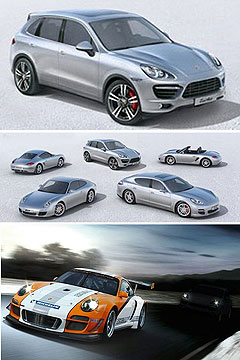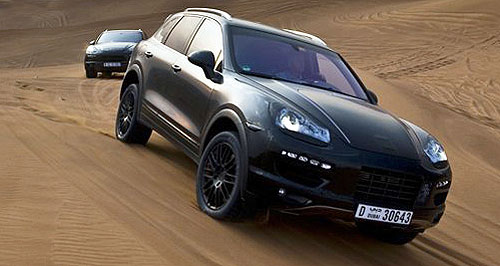Future models - Porsche - CayenneSneak-peek: New Porsche Cayenne nearly hereOn its way: Official testing shots of the new Cayenne have emerged ahead of their release next week, and the vital new model's world debut at Geneva in March. More images and details of Porsche’s sleeker, second-generation Cayenne SUV emerge19 Feb 2010 PORSCHE’S sleek new Cayenne, now confirmed for release in Australia from late July, appears to have been officially outed - completely undisguised - via the company’s own new model configurator website, on which these images allegedly appeared briefly yesterday. Spy shots of the replacement for Porsche’s biggest selling model, which accounted for more than half of the German maker’s total sales last year in Australia have done the online rounds for months. And, as we’ve reported, official images of lightly disguised MkII Cayennes undergoing hot-weather durability testing have also surfaced on the web ahead of their formal release next week. Since then, in the build-up to the vital new model’s world debut at the Geneva motor show on March 2, Porsche has even shown the all-new Cayenne’s silhouette within a picture of the new 911 GT3 R Hybrid racecar. The vehicles in both official sets of images appear virtually identical to the undisguised Cayenne Turbo in the latest image, which Porsche has not confirmed as legitimate, debunking suggestions it is the work of a Photoshopper – or even the Audi Q5-based ‘Roxster’ compact SUV under development at Porsche. The image clearly shows the next Cayenne will look more compact and contemporary, thanks to dramatically shorter front and rear overhangs, ‘faster’ front and rear windscreens, more prominent bonnet and bodyside sculpting and a higher shoulder line beneath a narrower side glass area. While new design details include matt-black plastic wheel-arch and bumper extensions, the Turbo flagship injects even more aggression than before via a lower standard ride height, oversized tailgate spoiler and deeper front bumper with massive air-dams – the outboard inlets housing a new row on LED driving lights. Porsche Cars Australia is reluctant to divulge specific details of the new Cayenne range, but has confirmed it is now “in sell-down phase for our most popular model” ahead of the Cayenne’s release here in late July. Despite the arrival of its replacement in five months locally, Cayenne sales were up more than five per cent in 2009 – and up more than 18 per cent in January. While the petrol Cayenne model range goes on sale in the UK from May, Australia will see a “top-down” model rollout, likely to be led in July by the new Cayenne Turbo and followed soon after by naturally aspirated V8, hybrid and then V6 petrol and diesel versions. The next Cayenne, which again shares much of its chassis and other mechanical components with parent company Volkswagen’s new Touareg (to also debut at Geneva), continues the original model’s exclusive five-door, five-seat configuration. It will continue to be built alongside the new Touareg and current Audi Q7 at Volkswagen’s Bratislava factory in Slovakia, with final assembly occurring at Porsche’s Leipzig plant in Germany alongside the Panamera.  Left, from top: Images from Porsche's official online configurator website Porsche even revealed a silhouette of the new Cayenne among a selection of GT3 R Hybrid shots last week. Left, from top: Images from Porsche's official online configurator website Porsche even revealed a silhouette of the new Cayenne among a selection of GT3 R Hybrid shots last week.Autocar, which has taken part in a number of official final durability tests with Porsche, says that despite a 45mm-longer overall length, 40mm-longer longer wheelbase, wider wheel tracks and the fitment of an extra 70kg of standard equipment, the MkII Cayenne will be about 10 per cent - or a substantial 180kg - lighter than its predecessor in basic V8 (Cayenne S) form, at 2065kg. That should make all versions of the new model more economical, despite the fact they will come with 4.8-litre V8 engines that are more powerful than both the current Cayenne and the Panamera. Although all models will match BMW’s facelifted X5 (but not the PDK-equipped Panamera) by offering an eight-speed automatic transmission as standard, the entry-level diesel model will bring the least mechanical changes in the form of a lightly upgraded 3.0-litre TDI V6 from Volkswagen. The next six-cylinder petrol Cayenne will also continue with a 3.6-litre VW V6, offering similar output the 220kW Porsche-developed unit announced this week for the Panamera, while the hybrid will mate the Audi S4’s supercharged 245kW/440Nm 3.0-litre V6 with a 38kW electric motor to deliver 275kW/550Nm - giving it similar total power but more torque than the new 283kW/500Nm-plus Cayenne S. As a result, Porsche’s first hybrid model, which houses its lithium-ion battery pack in the spare wheel well, will be quicker and more expensive than the Cayenne S (currently priced at $146,900), despite the fact it will be the most frugal model in the Stuttgart brand’s range, with average fuel consumption of about 8.2L/1200km and CO2 emissions of 193g/km. Expect the Cayenne S Hybrid to sprint to 100km/h in a claimed 6.5 seconds, and offer a towing capacity of up to 3500kg, while the Turbo retain its position at the top of the Cayenne tree with 0-100km/h acceleration in 4.6 seconds – half a second faster than before. The diesel is again expected to comprise up to 40 per cent of cayenne sales in Australia, where the hybrid is forecast to attract anywhere between 15 and 25 per cent of total sales. “The claim will be that in terms of dynamics it (the hybrid) will still be a Porsche,” said PCA managing director Michael Winkler. “If you want a hybrid, here’s one that handles. If you’re considering a (Lexus) RX400h or other similar products coming from germany, then the promise is economy with superior dynamics.” Much of the second-generation Cayenne’s weight reduction is said to come via increased use of aluminium in the new bodyshell, doors, bonnet and tailgate, but the elimination of off-road equipment – including the current model’s low-range transfer case and locking rear differential – for all but the diesel model also slashes mass. We understand that following final benchmarking tests against BMW’s X6 all models should set new on-road dynamic standards, but only the diesel version will remain as capable off-road as the outgoing Cayenne. While petrol versions will continue with the current model’s multi-plat clutch-operated permanent all-wheel drive system, both the diesel and hybrid Cayennes are expected to run a Torsen four-wheel drive system similar to that of the Q7. However, GoAuto sources suggest that a super-low first gear ratio will give petrol models similar climbing capability to the diesel, which is not expected to receive other variants’ standard automatic idle-stop and regenerative brake energy systems. The new Cayenne will also receive a fully redesigned, larger and higher quality interior that borrows much from the Panamera, including its steering wheels, dashboard, instrument cluster and centre console with two rows of switchgear bookending the gearshifter. According to Autocar, the MkII Cayenne will also feature a more heavily contoured rear bench seat that slides 160mm fore-and-aft and offers a seatback that tilts by up to six degrees, while cargo space increases by 120 litres to 670 litres – or 1780 with the rear seats folded. The new Cayenne rollout will cap a busy year for Porsche Cars Australia, which releases the upgraded 911 Turbo this month, before launching the limited-run 911 Sport Classic, 911 GT3 RS and Boxster Spyder in April, the Panamera V6 in June and the order-only 911 Turbo S in August. Mr Winkler said that despite the arrival of a redesigned version of its top-selling model for the second half of this year, Australian Porsche sales would remain static in 2010. "My target is to maintain the volumes (achieved) over the last 12 months," he said at this week's 911 Turbo launch. "The reason I want to maintain and not increase is simply that given that we will have in our biggest selling model a generational change this year, we're obviously going into a sell-down phase. That's going to have an effect on what the overall numbers for the year will be. "In that context, if we maintain the same figure as last year, I'd say we've done reasonably well. If we manage to do better than that, I'll take it," said Mr Winkler.  Read more18th of February 2010  First look: Porsche produces Panamera V6First Porsche-designed V6 to power most basic Panamera - due here in June1st of February 2010  Next Cayenne surfaces as Roxster, sub-Boxster firmed upPorsche puts sub-Cayenne and Boxster models on drawing board as new Cayenne surfaces13th of November 2009  Porsche holds tight on product reinsShared models not a problem, as long as we lead development, says Porsche12th of November 2009  New Porsche Cayenne Hybrid here in a yearHybrid expected to be one of the top-selling versions of Porsche’s new 2010 Cayenne13th of October 2009  Panamera laps Oz – now for the convertiblePorsche hints at Panamera ‘family’ as its first four-door completes Oz launch24th of August 2009  Porsche Roxster lives againPorsche to resurrect sub-Cayenne SUV and sub-Boxster sportscar under VW26th of February 2009  First details: Porsche’s Cayenne S Hybrid2010 Porsche Cayenne to get VW Touareg’s supercharged hybrid10th of February 2009  First details: Volkswagen reveals first hybrid SUVGerman giant unveils plans to mass-market a petrol-electric VW Touareg in 2010All future models Alfa Romeo Alfa Romeo Abarth Abarth Audi Audi Aston Martin Aston Martin BMW BMW Bentley Bentley Chrysler Chrysler Chevrolet Chevrolet Dodge Dodge Citroen Citroen Ferrari Ferrari DS DS Ford Ford Fiat Fiat FPV FPV Foton Foton Haval Haval Great Wall Great Wall Honda Honda Holden Holden Hyundai Hyundai HSV HSV Isuzu Isuzu Infiniti Infiniti Jeep Jeep Jaguar Jaguar Lamborghini Lamborghini Kia Kia Lexus Lexus Land Rover Land Rover Mazda Mazda Maserati Maserati Mercedes-Benz Mercedes-Benz McLaren McLaren Mini Mini Nissan Nissan Mitsubishi Mitsubishi Peugeot Peugeot Opel Opel Proton Proton Porsche Porsche Renault Renault Ram Ram Saab Saab Rolls-Royce Rolls-Royce Smart Smart Skoda Skoda Subaru Subaru SsangYong SsangYong Tesla Tesla Suzuki Suzuki Toyota Toyota Volvo VolvoCayenne pricing
Motor industry news |
Click to sharePorsche modelsResearch Porsche All future models Alfa Romeo Alfa Romeo Abarth Abarth Audi Audi Aston Martin Aston Martin BMW BMW Bentley Bentley Chrysler Chrysler Chevrolet Chevrolet Dodge Dodge Citroen Citroen Ferrari Ferrari DS DS Ford Ford Fiat Fiat FPV FPV Foton Foton Haval Haval Great Wall Great Wall Honda Honda Holden Holden Hyundai Hyundai HSV HSV Isuzu Isuzu Infiniti Infiniti Jeep Jeep Jaguar Jaguar Lamborghini Lamborghini Kia Kia Lexus Lexus Land Rover Land Rover Mazda Mazda Maserati Maserati Mercedes-Benz Mercedes-Benz McLaren McLaren Mini Mini Nissan Nissan Mitsubishi Mitsubishi Peugeot Peugeot Opel Opel Proton Proton Porsche Porsche Renault Renault Ram Ram Saab Saab Rolls-Royce Rolls-Royce Smart Smart Skoda Skoda Subaru Subaru SsangYong SsangYong Tesla Tesla Suzuki Suzuki Toyota Toyota Volvo VolvoCayenne pricing
Motor industry news |
















Facebook Twitter Instagram